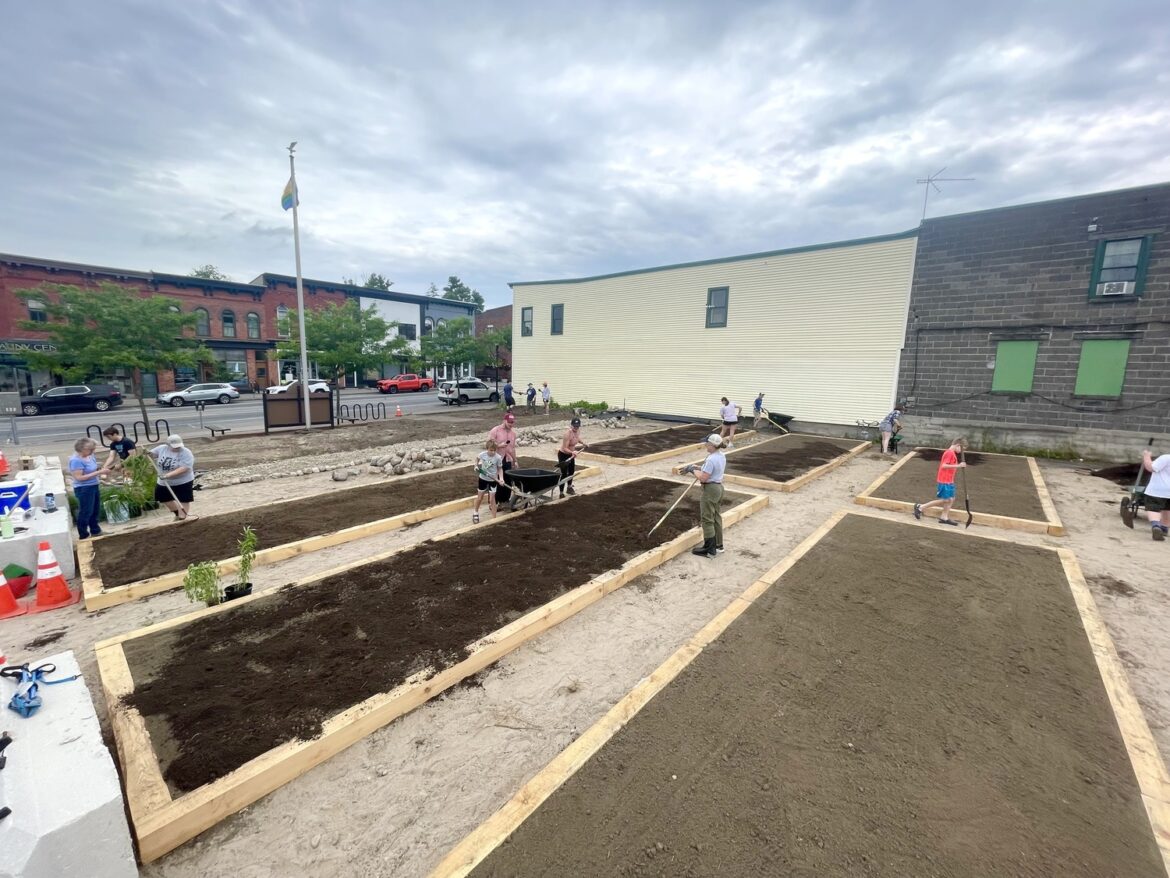Aug 11, 2025 —
Noah Donnellan-DoserCanton garden beds are a model of how to make yards more flood resilient
After heavy flooding from Hurricane Debby last summer, a group of volunteers in downtown Canton is building a “demonstration garden” to give residents a real-life example of how to make their yards more environmentally friendly and resilient to stormwater flooding.
In a vacant lot on Main Street, there are six wooden-frame garden beds and two massive piles of soil and woodchips.

Canton’s new demonstration garden at 23 Main Street. Photo: Catherine Wheeler
Cathy Shrady, chair of the Canton Sustainability Committee, is scooping soil from a packed wheelbarrow onto a bed. Then, a volunteer rakes the soil evenly across it.
The beds will soon be filled with native wildflowers that attract pollinators.

Canton Sustainability Committee Chair Cathy Shrady dumping soil onto a raised bed. Photo: Catherine Wheeler
“If you like food, you should like pollinators. We get crops because they get pollinated,” said Barbara Beekman, a village trustee.
Pollinator numbers are falling worldwide, largely due to development and the use of pesticides. So, it’s essential to cultivate spaces that encourage pollinator growth.
“The more pavement, the more non-nurturing landscape there is, the less pollinators there are,” says Beekman.
Around her are volunteers from St. Lawrence University’s Center for the Environment, the Canton Middle School, and the Village Board. They’re shoveling the soil and pulling up roots.
Near the Main Street sidewalk, volunteers are lifting volleyball-sized rocks and layering them along a shallow ditch. Executive Director of the Center for the Environment Diane Husic says they’re creating what’s called a swale.

Volunteers hard at work in the old McDonald’s lot. Photo: Catherine Wheeler
“This building that’s next to us doesn’t have any gutters, and there’s a low point, so all the water ran and it would sit at the base of the foundation,” she said. “This ditch that they’ve dug will basically direct the water away from the building and then go into a deep area there.”
She points to the end of the ditch, where water will collect. An elevated bank, known as a berm, has already been built to help manage water flow.
Shrady says the lot would have been more prone to flooding without the garden in place. It likely would have damaged the police station and town hall next door.
“It could have been paved over to make more parking spaces, but that’s about the worst thing you can do if you’re trying to deal with rainwater, because paving just makes the water run off,” said Shrady.
Last summer’s heavy flooding from Hurricane Debby in St. Lawrence County has increased the urgency of building resilience to more intense storms fueled by climate change.

Executive Director of the Center for the Environment Diane Husic pulls roots up next to the berm and swale. Photo: Catherine Wheeler
Many Canton residents are concerned that the village’s drainage system is too outdated to handle those bigger storms. Governor Kathy Hochul recently announced a statewide infrastructure grant to help municipalities reduce stormwater flooding, of which Canton received $500,000.
Shrady says their goal for the garden is to show people how to bring these solutions into their own homes and bring some beauty to downtown Canton.
“It’s a simple thing that homeowners can do that’s pretty easy. [It] doesn’t cost a lot to help manage stormwater,” said Shrady.

Wildflowers bloom in the new garden beds on Canton’s Main Street. Photo: Nora Kenyon
On the other side of the swale is a rough patch of dirt ready to be filled with alternatives to grass that are lower maintenance and require less water.
“We’re going to put in microclover, which is good for soil and brings nitrogen into soil,” she said. “Then, we’re going to put in little bluestem, which is a perennial prairie grass – a warm-season grass that has really deep roots, so it helps with erosion.”
Beekman says the garden is a great way to showcase downtown Canton and teach some ways to foster a more sustainable home.
“It’s not a perfect fix, but we’re hoping to combine some education with some beauty,” she said.
It’s unclear how long this demonstration garden will stay. According to Beekman, the town plans to build a new municipal building in its place, but the project is still in its early stages of development.


Comments are closed.